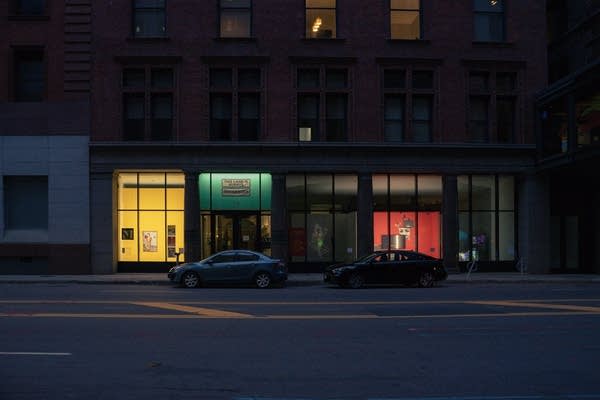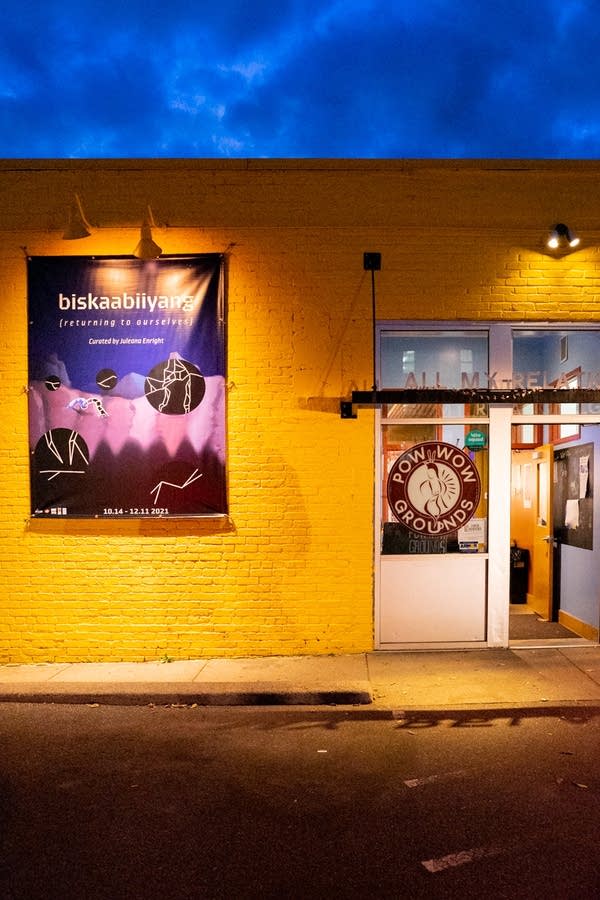'Where power resides' — Flipping privilege in the art curator paradigm

Go Deeper.
Create an account or log in to save stories.
Like this?
Thanks for liking this story! We have added it to a list of your favorite stories.
Updated: 8:14 a.m.
When you think of a curator, who do you see? Perhaps a well-heeled individual in a white box gallery or the soaring halls of a museum.
Juleana Enright is a local arts writer and curator. Historically, Enright says, a curator was someone with the trappings of privilege.
“I think that there was this notion that to curate, you had to have a collection or be in proxy to a collection, and that you had to be white, male, old, rich,” Enright says.

Many in the art world are beginning to push for more inclusivity, to shift the role of curator from cultural gatekeeper to something more like a community builder and sharer of cultures.
Turn Up Your Support
MPR News helps you turn down the noise and build shared understanding. Turn up your support for this public resource and keep trusted journalism accessible to all.
Enright is one of these folks: Indigenous (Lower Brule Lakota Tribe of South Dakota), queer and nonbinary. They curated the 2021 group exhibition “Biskaabiyang (Returning to Ourselves)” on Indigenous Futurism at All My Relations Arts in Minneapolis.
“To me, it was a little bit of a radical show,” Enright says. “Just the way that there are a lot of younger artists who are kind of pushing the definitions of what it means to be a Native artist or an Indigenous queer artist, or not following the traditional realms of what people think Native art should be.”
“Biskaabiyang” featured a lot of digital work, including a video game by a Native artist, Enright says, rather than pigeonholing Native art into traditional crafts like basket-weaving and beadwork.
“The cultural landscape for curation is really changing,” Enright says. “And especially if you're interested in it, you can see it changing really rapidly.”

Enright is an alum of the Emerging Curators Institute, an initiative based in the Twin Cities.
ECI is providing a singular service in the region, and perhaps the country: A non-institutional pathway for people who don’t see themselves reflected in the field of art curation. That is, women, people of color and the LGBTQ community, says ECI founder Jehra Patrick. She wants the idea of a curator to become more flexible.
“The role of the curator really originated as that of a caretaker,” Patrick says. “And that definition has evolved within the museum world as someone who is really in a position of power, and a gatekeeper to what aspects of art and culture get inducted into our histories by way of collection and exhibition.”
While studies are scarce on the demographics of curatorial professionals, some early data matches much of Patrick’s findings.
The Mellon Foundation published the findings of its third Art Museum Staff Demographic Survey at the end of 2022 (the foundation first started collecting this data in 2014). The percentage of staff in curatorial roles has remained predominantly female (74 percent in 2014, and 76 percent in 2022) and white (73 percent). In 2014, 82 percent of staff identified as white. While some progress is identifiable, the survey says it is slow.
“People of color still fill under 25 percent of certain important positions, and gains among Black and Indigenous staff have been limited,” it says.

Patrick, an artist and curator herself, says she founded ECI a few years ago because of a gap she perceived in the arts ecosystem. She found Minnesota to have what she calls a thriving philanthropic environment for artists and artist organizations.
“But as an aspiring young curator, there were no funded opportunities for curators to develop new projects,” Patrick says.
In 2016, she canvassed art professionals locally and nationally about how to best fill this gap. The barriers, she found, were largely economic and academic.
“The field has been limited by those who can get an advanced degree and then perhaps go on to receive a fellowship or an assistantship within museums,” Patrick says. “So, it's really created a narrow field.”
Essentially, ECI’s program is professional development outside of a university or institutional setting. Fellows receive funding and are matched with a curatorial mentor to help produce their own exhibition.
Fellows also meet with their cohorts to discuss curatorial history, theory, and practice and any challenges they face. ECI has a public program too, bringing in guest speakers from around the world.
Fellows learn how to support artists, Patrick says.
“The future of [curation] is really working with people, building relationships and valuing artists as equals, rather than subjects,'“ Patrick says.
So, what does curation look like in 2023?
Like storytellers and bridge-builders, says Teréz Iacovino. She is a curator for the University of Minnesota Katherine E. Nash Gallery and a mentor for ECI.
“Often curators are folks that are advocates for artists, build platforms with artists, make sure artists get paid and really also make sure that stories that aren't being told in the arts are told,” Iacovino says.

For current 2022-23 fellow Za’Nia Coleman, curation is creating an affirmative space for her Black community.
“Sometimes curation can be talked about in this very distant hands-off approach of like, 'Curators can't do that, because then that shows bias; curators can't do that, because that's also making art.’” Coleman says. “And it was just that wasn't my practice.”
Coleman's approach is about sharing. Sharing meals, history, culture, art.
For her ECI exhibition, she's curating archival multimedia about Hollywood Studio of Dance in North Minneapolis, what she describes as a longtime cultural anchor in her community. The show will open in September at Public Functionary in the Minneapolis Northrup King Building.
“I'm also trying to take up more space,” Coleman says. “The idea of Black feminist theory is that Black women get to be the author and the authoritative hand on their message and what they're trying to do. For me, curation doesn't look like me not touching anything.”
While Coleman is developing her exhibition, the institute is getting ready to announce its 2023-24 cohort.

And they announced another transition: Patrick recently took the position of executive director of the Highpoint Center for Printmaking in Minneapolis. After an international search, she's passing the director torch to Barak adé Soleil, an artist and curator based in London. He has Minnesota connections that go back decades.
“Minnesota is where I truly grew and emerged as an artist and began to understand what it meant to also engage in curation,” says adé Soleil, who is from Chicago.
Adé Soleil first worked in the realm of curation with the former nonprofit Minnesota Men of Color and Intermedia Arts. He will be relocating to the Twin Cities this spring with a vision for the institute based on his lived experience as a queer, Black and disabled person.
“We're taking an intersectional approach to become aware of where power resides and the absences that have led to initiatives such as ECI,” adé Soleil says. “An approach that embraces also those who are disabled, those who are queer, those who are within Black, Indigenous and folks of color who might not have felt that the space was for them that it could be possible."
Correction (March 2, 2023): A previous version of the story inaccurately described several artist's identities; the story has been corrected.



